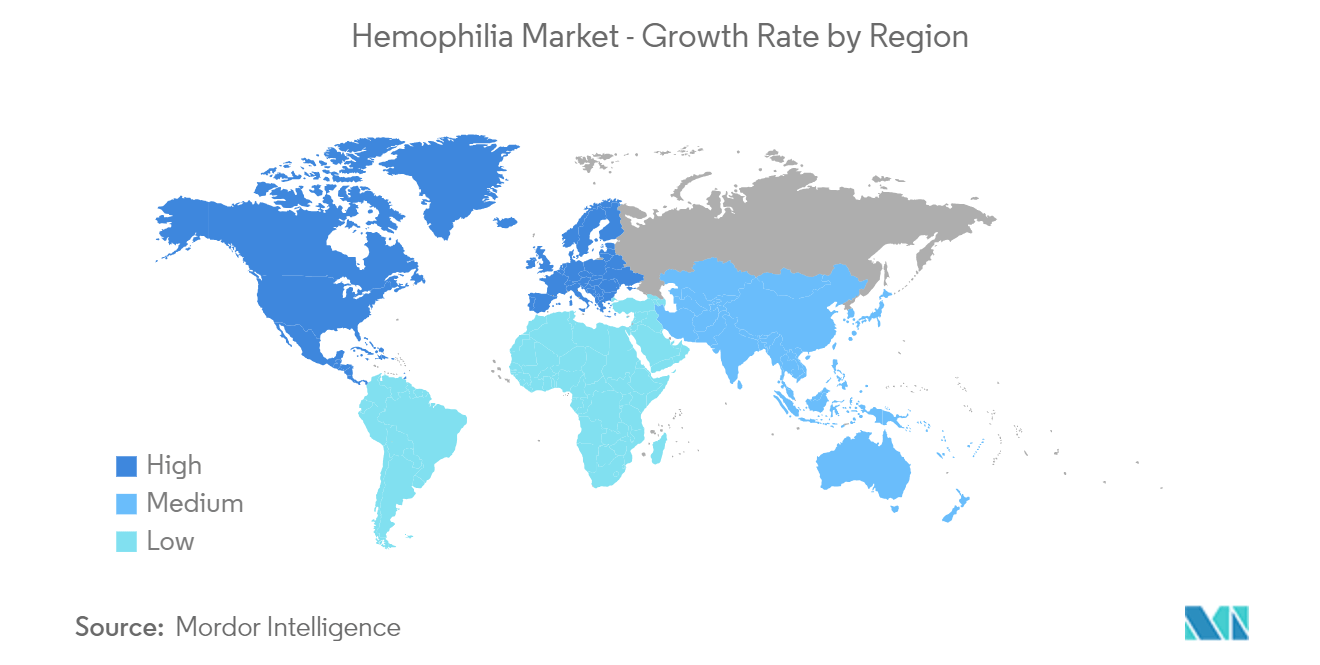Market Trends of Hemophilia Industry
Hemophilia A is Expected to Hold Significant Market Share in the Disease Type Segment
Hemophilia A is the most common severe bleeding disorder. Replacement therapy, providing the missing coagulation factor, was the mainstay of treatment both prophylactically and to treat bleeding. Hemophilia A is expected to hold a significant market share over the forecast period owing to factors such as an increase in the prevalence of hemophilia A cases, a rise in awareness programs, and a surge in different therapies for hemophilia A. For instance, as per the data published in June 2024 by the Hemophilia Foundation Australia, hemophilia occurs in one in 6,000 to 10,000 males internationally. Approximately one in 6,000 males have hemophilia A. A total of 208,997 people worldwide were affected by hemophilia A. Thus, the high burden of hemophilia A is expected to contribute to the growth of the segment over the forecast period.
Furthermore, product approvals, clearances, and launches are expected to increase market opportunities during the forecast period. For instance, in August 2022, the European Commission (EC) granted conditional marketing authorization to valoctocogene roxaparvovec gene therapy under ROCTAVIAN. BioMarin includes multiple clinical studies underway in its comprehensive gene therapy program for treating severe hemophilia A. Similarly, in June 2022, the FDA granted Breakthrough Therapy designation to efanesoctocog alfa (BIVV001) for treating people with hemophilia A. It is a rare, life-threatening bleeding disorder based on pivotal XTEND-1 Phase 3 study data. Sanofi and Sobi collaborated on the development and commercialization of efanesoctocog alfa.
Moreover, research and development to advance the treatment for hemophilia A are widely carried out, which is expected to fuel market growth over the forecast period. For instance, as per the article published in September 2022 in PubMed, various key players worked on an in vivo genome-editing program based on CRISPR/Cas9. This technique used non-homologous end-joining to prevent the loss of the AAV vector due to hepatocyte growth. It was to enable the permanent chromosomal integration of a modified human B-domain-deleted FVIII at the albumin locus in liver cells. Young individuals with hemophilia A who were ineligible for traditional gene therapy benefitted greatly from such a method.
Therefore, due to the increase in hemophilia A cases and the rise in different pipeline studies and product approvals for hemophilia A, the segment is expected to witness significant growth over the forecast period.

North America Expected to Hold Significant Share in the Market and Expected to do Same Over the Forecast Period
North America is expected to hold a significant share of the market. It is expected to do the same over the forecast period due to factors such as the rise in hemophilia cases, increasing awareness about technologically advanced products, and favorable regional government initiatives. For instance, according to the CDC update in August 2022, about 33,000 people in the United States were diagnosed with hemophilia. Hemophilia typically affects men and people assigned male at birth (AMAB). As per the same source, the estimated prevalence of hemophilia in the United States is 12 cases per 100,000 US males for hemophilia A and 3.7 cases per 100,000 US males for hemophilia B.
Moreover, rising initiatives from key market players are also expected to drive market growth in this region. For instance, in February 2022, BioMarin Pharmaceutical Inc. presented positive results from a two-year Phase 3 GENEr8-1 study analysis and an overall safety update of valoctocogene roxaparvovec. It was an investigational gene therapy for treating adults with severe hemophilia A demonstrated at the 15th Annual Virtual Congress of the European Association for Haemophilia and Allied Disorders (EAHAD).
Additionally, approvals and clearances for hemophilia-related products and therapies are expected to bolster market growth over the forecast period. For instance, in October 2022, Novo Nordisk received Health Canada’s approval for a new indication for REBINYN (Coagulation Factor IX [recombinant], pegylated) for the treatment of routine prophylaxis in hemophilia B patients aged less than 18 years. REBINYN is now indicated in all ages with hemophilia B (congenital factor IX deficiency or Christmas disease) for routine prophylaxis to prevent or reduce the frequency of bleeding episodes and control and prevent bleeding in a perioperative setting.
Thus, North America is expected to register a significant market share over the forecast period due to the increase in hemophilia cases and the rise in different therapies for hemophilia, coupled with research and development.



